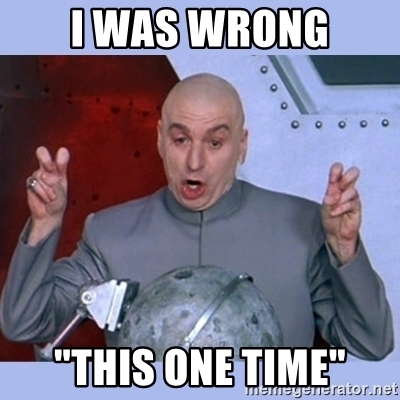
Trial and Error = An Underutilized Way to Learn
About a two weeks ago I received an email from a newly minted trainer in the industry who had read THIS article on program design I wrote not too long ago.
Sheepishly, he admitted that program design was one of his weak points and that he felt he was ill-prepared to write effective one’s despite having recently completed the certification process.
I could relate.
I recalled how in the first few months of my personal training career I felt like an abject failure when it came to writing programs for my clients.
Here’s how it went:
Client: “Hi.”
Me: “Hi.”
Client: “Can you write me a program to help me reach my goals?”
Me: “Brb.”
(cooly turns around and heads off to the back room to hyperventilate into a paper bag)
(10 Minutes Later) Me: “Yes, I can do that.”

In the time between those initial few months and now I’ve written roughly, I don’t know, 5,000-7,000 (+/- infinity) programs for a menagerie of individuals and backgrounds. Many have been influenced by books I’ve read, lectures I’ve listened to, and/or conversations I’ve had with other colleagues of mine.
Moreover, many have their roots in me just spit-balling and experimenting with an idea of concept. There’s a thought process behind them of course; I’m not just blindly tossing things at the wall and seeing what sticks.
However, I’d be remiss if I didn’t just come right out and say that a portion of my program writing process is me just saying to myself, “let’s see what happens if I do this.”
No one has died or lost an appendage yet…😉
More to the point: I’ll be the first to say that NONE of my programs have been perfect. Even today I am constantly x’ing stuff out, changing this exercise to that, adjusting loads, regressing, progressing, or otherwise flat out changing my mind.
Sometimes I’m overzealous, sometimes I’m too reserved.
Sometimes I’m wrong.
I’m not scared to admit it.

Nevertheless, the point is: I am always leaning into the process and accepting the fact that I am (and will always be) thiiiiiiis close to grabbing that paper bag.
Which brings me back to the new trainer from above.
As he and I were corresponding back and forth he proposed something to me. He wanted to see if I could help him find another coach to mentor him and to possibly write programs for a few of his current clients.
- He’d provide the details.
- The other coach would write the program
- Then he’d want to “dissect” the program with the other coach to ask more of the why’s and how’s behind the program.
I gave him two pieces of advice:
1. To seek out a local trainer/coach that he could shadow/observe on a semi-regular basis. This is something I wish I would have done earlier in my career.
It would have helped tremendously.
There’s an abyss of value in having the ability to watch another coach in real-time do his or her thing and to also have the opportunity to ask questions.
Most coaches are more than willing to have people stop by and shadow.
2. JUST DO IT.
Oftentimes the best way to learn or get better at something is by doing.
- If you want to get better at playing chess you play chess.
- If you want to get better at a particular type of dance you do that dance.
- If you want to get better at not getting laid, you go to Anime conventions.
- Juuuuuuust kidding.1
I reminded him that he won’t write perfect programs. That’s an awful expectation to put on himself. I reiterated to him that his client’s wouldn’t need “perfect” programs, but rather just some semblance of progress.
Let’s be real: Most people see improvements in spite of what their program has them doing.
It’s more about being consistent with something, anything than it is whether or not they’re following an undulated, block periodization plan centered around quasi-isometric eccentrics.
If you’re a new trainer the best way to learn how to write programs is to jump in and do it.
Trial and error is a great learning tool.


